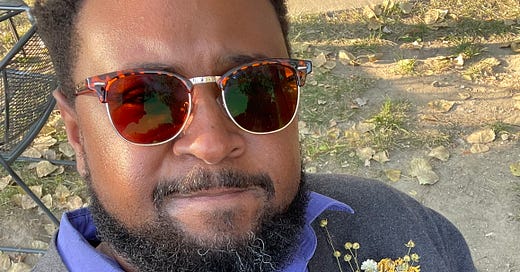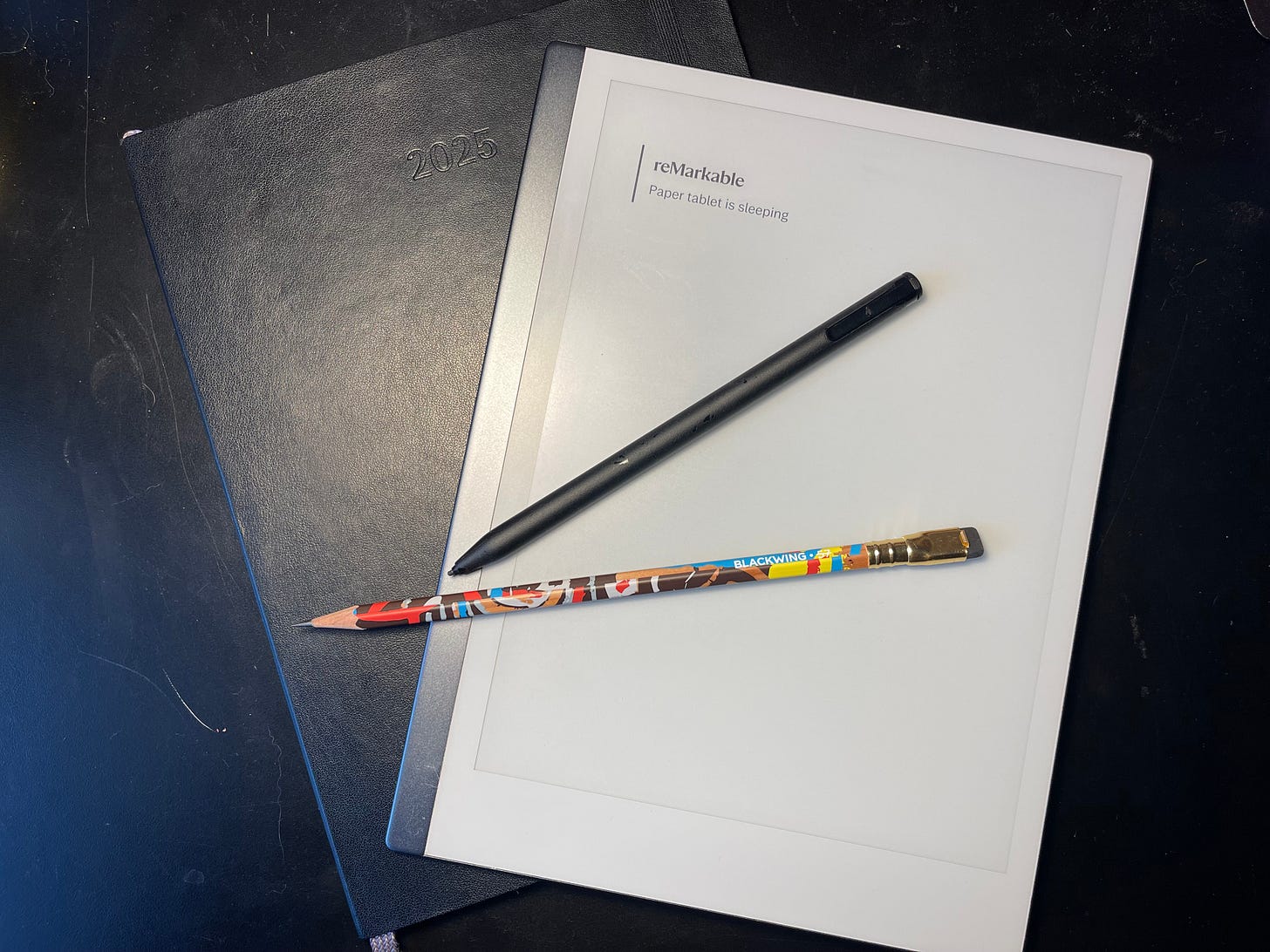Instrument, Surface, Setting, Story: An Interview Series on Creative Tools and Spaces with Donald Quist
"I want to make art that makes connections, wild associations like the ones pinging around my brain. I enjoy looking seriously at media that academia and critical institutions might view as unworthy."
Recently during a journaling workshop I participated in, the conversation turned to writing supplies and which journals, pens, and writing environments each of us prefer. The conversation went on for almost an hour and I realized once we’d moved on that I could have listened to other writers and artists talk about their chosen supplies all night. I decided to reach out to the creatives in my life to ask them about four components of their creative process, and I am so grateful for the generous responses they provided. I can’t wait to share them all with you.
Donald Quist is the author of two essay collections: Harbors, a Foreword INDIES Bronze Winner and International Book Awards Finalist, and To Those Bounded. He has a linked story collection, For Other Ghosts. His writing has appeared in AGNI, North American Review, Michigan Quarterly Review, Poets & Writers, The Rumpus, and was Notable in Best American Essays. He is creator of the online nonfiction series PAST TEN. A print anthology, The Past Ten, is now available for pre-order and will be released March 2025 from Cornerstone Press. Donald has received fellowships from Sundress Academy for the Arts and Kimbilio Fiction. He is Assistant Professor of Creative Nonfiction at University of Missouri.
Donald is serving as the judge for Craft Magazine’s Memoir Excerpt & Essay Contest. The deadline to submit is January 15, 2025.
Implement: What writing tool do you use? Pen? Pencil? Tablet? Or do you go old-school with a quill and ink?
I like writing by hand. It activates a part of my brain that allows me to be most generative. When I’m at a computer I write slower and am prone to overthink each word. The act of handwriting frees me from worrying about finding just the right synonym, structure, or syntax.
I use a Remarkable. It’s one of the best purchases I’ve ever made for my career. I call it my “second brain.” It converts my handwriting to text. I used to fill legal pads and notebooks and then have to transcribe my scrawl to a computer. So, the Remarkable has saved me a great deal of time and helped me produce faster. But fast isn’t always the goal; I like slowing down with pencil and paper every day to journal, annotate and draw.
Blackwing pencils are my favorite. I’ve even got one tattooed on my left arm—I’m a fan. They are well-crafted and well-designed, and feel good in my hand. The square ferrule prevents them from rolling off my desk. It’s clear a lot of care and intention went into their manufacturing and I like to think about that as I make stuff with them.
For grading, quick notes, edits, and book annotations, I like a Zebra F-301 Retractable Ballpoint pen.
I also make ample use of the Notes app and Google Docs on my phone when I’m in the revision process.
Surface: What do you write on? A lined paper journal? Dotted? Grid? Do you flip the page sideways or write long-ways?
Beyond the Remarkable, I write on/in a soft cover Monthly Moleskine Notebook. It’s a paper calendar with lined pages between months that helps me organize my life and projects. I travel with a small Blackwing notebook that allows me to take notes wherever I go. It fits in my back pocket and has a holder for a pencil or a pen.
When journaling, I use a college-ruled composition book. The cheaper the better. Gimme those 80 cent jawns! There’s this balance I’m looking for between the expensive pencil on very inexpensive paper. It makes me thoughtful, but not too precious about the words, and more honest. Hmmm, I might be figuring out something deeper about my psyche as I write this. Ha! An epiphany… My life and work is about bridging gaps between what is perceived as worthy of exaltation and acclaim, and what is dismissed and/or excluded as unserious.
I want to make art that makes connections, wild associations like the ones pinging around my brain. I enjoy looking very seriously at media that academia and critical institutions might view as unworthy of analysis. I have an aversion to pretention, but I also know I have the capacity to be really bougie.
I’m attracted to uncommon things, and I like being a contrarian. Often I come to major cultural phenomenon late because I won’t allow myself to enjoy them at the height of their popularity, lest I accept that I also hold the capacity to be basic. I think my writing accoutrements are a microcosm of this larger conflict within me. Wow.
Setting: Where do you create? An office? From bed? On the couch? Is it silent, or do you need background noise like music (with or without lyrics)?
Right, back to my writing stuff. I’ve got a great office on the University of Missouri campus. I never write there. Lawd, I’ve tried. I’ve worked really hard to make it a space to inspire creativity. I’ve been able to grade and answer emails there—even draw there—but I’ve yet to generate prose in that space. I’m not sure what that’s all about. And there may not be enough room in this brief write-up to unpack all of that.
I write best in public. Coffee shops mostly. Louder is best. I think I need the energy of other people doing stuff around me. I also work better when I have something else to ignore. I have to have headphones.
Music is integral to drafting new pages. Every project has a playlist. I’ve written essays and short stories with a single song on repeat for hours. I like Bebop and Post-Bop Jazz. A lot of Jazz Hip Hop. But it all depends on the mood of the project. Sometimes it needs to be Pop Punk. Never Opera. Never Opera. (squints dubiously)
I also have a home office where you can find me seated at least an hour most days, or much longer whenever a deadline looms. The desk is one of those public-school lab science tables. It makes me feel like I’m doing experiments when I write at it. It’s covered in knick-knacks from friends, a lamp, books, and a blue Toyo Steel co, Ltd. toolbox that holds small office supply items. Above the desk hangs art from people I love and admire.
Story: Describe your perfect writing day in three sentences or less.
Wake up. Go on an hour-long walk or go to the gym. Come home. Shower. By this point ideas and lines are already starting to flow. Eat something. Head to a coffeeshop, a library, or to the home office. With a cup of decaf coffee, plug in the headphones and write until my hand cramps, someone calls, or I get hungry.
Go do something else with people I love for a while—try not to think about writing at all.
After dinner, read and make annotations. Journal about the day at my desk. As the day comes to an end, review what I wrote earlier (on a laptop or my phone) making revisions, tightening and tweaking. If I do all of this, I fall asleep feeling pretty great about life on and off the page.
Donald is this year’s guest judge for Craft Magazine’s Memoir Excerpt and Essay Contest. Submit your best longform creative nonfiction, from 1,001 to 6,000 words. Three winners will receive $1,000 each and publication! Submission guidelines and link to submit can be found here. Deadline is January 15, 2025.








Thanks again for the invitation to do this! It was a lot of fun.